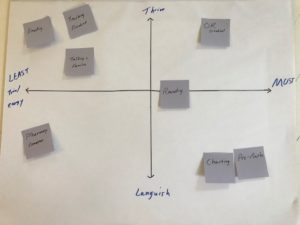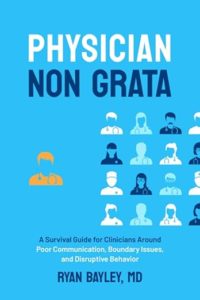Job Crafting – The Art of Thriving at Work (Part One of Three)

Closing The Gap Blog – April 2019
Job Crafting 101
Our jobs are collections of relationships, responsibilities, and tasks that when combined deeply impact how we experience our work as physicians. And we tend to think that much of how we do this work is beyond our control – dictated by managers and the system at large. It’s easy to feel that our physician responsibilities are communicated in a top down manner, and that we are simply the passive recipients of those job demands that we then have to execute.
Recent research, however, has focused on how each of us can make proactive changes even in the most structured and regulated jobs – a process known as job crafting. Regardless of our speciality or work environment, job crafting shows us that each of us has more latitude than we realize to craft the tasks we do, the relationships we engage in, and the way we conceive of the meaning and purpose of what we do.
Known as task crafting, relationship crafting, and cognitive crafting respectively, these three job crafting tools have been shown to dramatically improve psychological well-being and performance! In our work coaching physicians, job crafting is often the first step to solving the fulfillment puzzle.
In this three part series, we will explore how you can successfully use each of these three tools to change your experience of your work!
Step 1: Task Crafting
Task crafting refers to “taking on more or fewer tasks, expanding or diminishing the scope of tasks, and altering the way tasks are performed.” We begin with task crafting because it is the most concrete of the three approaches.
You might think that you understand well the tasks you do in your work – after all you are the one doing them! Yet in reality most of us have a poor understanding of the time we dedicate to various tasks. We also often don’t register the impact of those many tasks individually on our well-being. We may have an overall sense of dissatisfaction, but we often can’t parse out all the individual tasks we do and identify which ones energize or drain us. This is not surprising – as physicians we are so busy “firefighting,” constantly reacting to the incredible demands on our time and attention, that we rarely have time to reflect.
Thus in order to task craft, we must slow down and cultivate an appreciation for the many tasks that we do. We need to ask whether they energize or drain us, and quantify the amount of time we actually spend on them. A great exercise for this is the Thrive and Languish Chart.
First, write down all the tasks that you do on a weekly basis on notecards or post-its. The key is to get specific. Examples might include: “rounding,” “planned OR cases,” “emergent OR cases,” “documenting,” “talking with families,” “preparing/giving resident lectures,” etc.

Thrive-Languish chart in progress
Once you have the tasks, you make a four quadrant chart, with “thriving” at the top of the Y axis, and “languishing” at the bottom. “Least time/energy” goes on the left of the x-axis, and “Most time/energy” on the right. Next you simply sort the cards or post-its onto the chart.
Once you do this, journal on your initial thoughts. Next, live with the chart for a week and see how true it actually is for you. As needed, you can adjust where tasks are or add new ones as they come up. The physicians we work with often have profound insights as a result of comparing how they thought they were experiencing their work to how they actually experience their work. This may include realizing that tasks initially thought of as enjoyable or unenjoyable may not be as initially thought. Sometimes the amount of time spent on various tasks is also quite surprising.
Once this chart is refined using a week of real world experience, its time to craft! The goal is to find any possible changes, not matter how small, to increase the time and attention paid to engaging activities, while decreasing time and energy on those that drain you. It is also about seeing how you can change how you execute those tasks as well.
The 80/20 rule tells us that most of our satisfaction comes from just 20% of what we do; likewise, 80% of our dissatisfaction comes from just 20% of what we do. Thus, even small changes in either of these areas can have a disproportional impact on our experience.
Furthermore, in keeping with this idea, research at the Mayo Clinic into physician wellness found that if you can hit the threshold of spending just 20% of your weekly time on truly meaningful activities, then job satisfaction dramatically increases and burnout is cut in half.
So looking back at your chart, there are a couple of commonly employed strategies to try:
Increase The Good – Time famished physicians are often in “defense mode,” trying to avoid any additional demands for their time and attention. Paradoxically, however, multiple studies have show that physicians who decrease burnout actually do so by increasing time spent on meaningful activities or even adding new activities for growth or challenge. The key, of course, is that the activities must be intrinsically rewarding, not things you “should” do.
Looking at your chart, what activities would you increase if you could? Again, focus on small changes. What steps would you take to make just a 5% gain? Also, what would you add? Are there any meaningful activities that you used to do that you miss? What were some peak experiences at other times in your work and how can you replicate those here? How do you want to grow or be challenged in the next year?
Decrease The Bad – Of course, the opposite strategy is also valuable. What can you decrease or say no to?
Physicians in general have a difficult time saying no and delegating. It is part of our DNA to be hyper-conscientious and have an exaggerated sense of responsibility. This results in a “go it alone” attitude where we take on anything and everything asked of us. If you’ve ever found yourself saying “if I want it done right I’ll just do it myself,” you likely suffer from delegation problems. Unfortunately, in modern healthcare, this is a recipe for burnout. Furthermore, when we take on tasks that are not in keeping with our values, strengths, or sense of purpose we don’t do them as well and feel drained by them.
With this in mind, what have you taken on that you should not have? What can you say no to, or at least start to slowly entangle yourself from? Examples may include a research project or committee. Or, if you find teaching and research responsibilities burdensome, why are you in academics? Also, where can you delegate to others, particularly support staff?
Get Good At The Bad – The above two strategies focus on shifting the time spent on activities, ie, moving them left or right on your chart (or taking them off completely!). But, in reality, there will always be parts of our work that we don’t like and cannot get rid of or even appreciably decrease. So what about changing how we do those tasks?
Look at the lower right quadrant of your chart – the activities that drain you that you also spend a lot of time on? Is there a way to at least get better at these so that you could move them up slightly, ie, so that they are less draining? How might you leverage technology, develop new skills, or better work with and through those around you to alter your experience of these tasks? You may never get them above the Thrive-Languish line, but even small moves upward can make a big difference.
A very common example is the electronic health record. Most physicians languish in this regard, spending a lot of time on documentation. And let’s be honest, the EHR isn’t going away. So if its not going away, at least you can become an EHR super-user. Most physicians think they are efficient at the EHR. In reality, only about 10% of physicians use the EHR to its full capabilities. Have you taken additional classes in your EHR, or had your EHR vendor come back out for additional training? Have you worked with an EHR coach? Do you make extensive use of templates, or use a scribe? Do you have other staff do as much of the data entry as possible (meds reconciliation, health screening, initial ROS, etc)? Have you done everything possible to reduce mouse usage, by switching to hot keys and speech recognition? Have you completely customized your EHR panel, or do you just engage with the default? All of these are just a few examples of how you can at least get better at the bad.
Most physicians we work with gain incredible value from the above exercise, and find that just 3-4 small changes over a few months dramatically improves their experience. You can also go one step further, and do this type of chart with your life as a whole. Tracking not just work tasks but life tasks can help you improve the bigger picture.
We challenge you to try this exercise for the next month, and see how it improves your experience. Make sure you follow up in our next newsletter where we will discuss part two of job crafting – relationship crafting!
 One instance of being labeled a poor communicator, uncivil, or disruptive can wreak havoc on your career.
One instance of being labeled a poor communicator, uncivil, or disruptive can wreak havoc on your career.